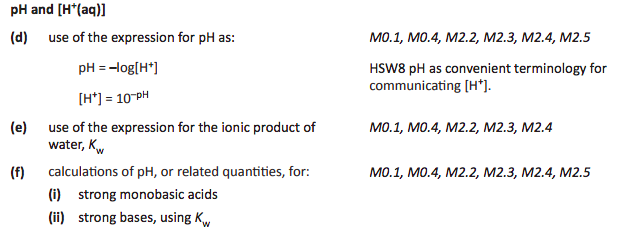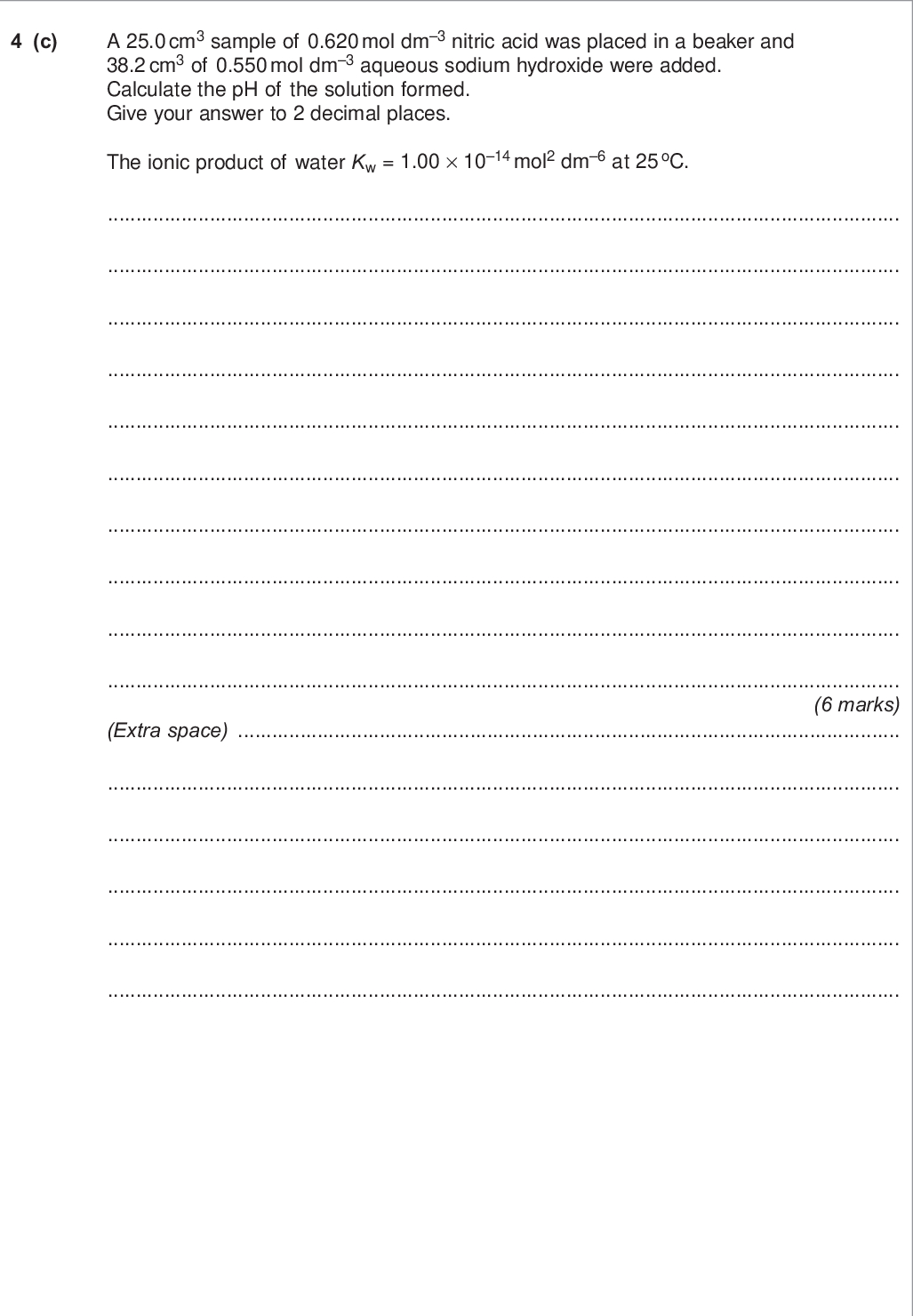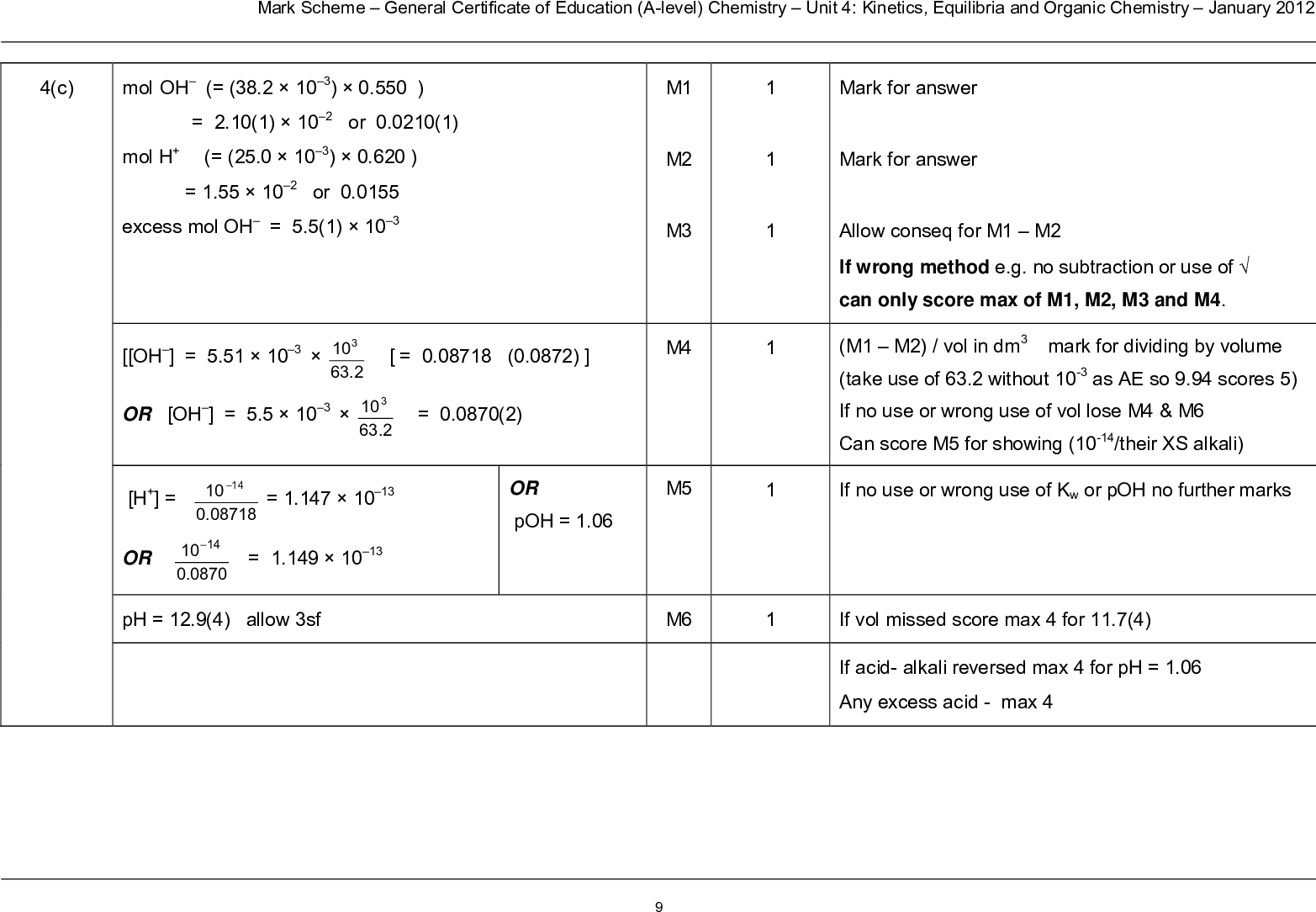



Calculating pH pH = – log [H+ ] Where [H+ ] is the concentration of hydrogen ions in the solution Calculating pH of strong acids Strong acids completely dissociate The concentration of hydrogen ions in a monoprotic strong acid will be the same as the concentration of the acid. For HCl and HNO3 the [H+ (aq)] will be the same as the original concentration of the acid. For 0.1M HCl the pH will be –log[0.1] =1.00 Always give pH values to 2d.p. In the exam Finding [H+ ] from pH [H+ ] = 1 x 10-pH On most calculators this is done by pressing Inv (or 2nd function) log – number(pH) Example 1 What is the concentration of HCl with a pH of 1.35? [H+ ] = 1 x 10-1.35 = 0.045M. Ionic Product for water [H+ (aq)][OH- (aq)] [H2O(l)] Kc= This equilibrium has the following equilibrium expression Kc x [H2O (l)] = [H+ (aq) ][OH- (aq)] Rearrange to Because [H2O (l)] is much bigger than the concentrations of the ions, we assume its value is constant and make a new constant Kw Kw = [H+ (aq) ][OH- (aq) ] Learn this expression At 25oC the value of Kw for all aqueous solutions is 1×10-14 mol2dm-6 The Kw expression can be used to calculate [H+ (aq)] ions if we know the [OH- (aq)] ions and vice versa Finding pH of pure water Pure water/ neutral solutions are neutral because the [H+ (aq) ] = [OH- (aq)] Using Kw = [H+ (aq) ][OH- (aq) ] then when neutral Kw = [H+ (aq) ]2 and [H+ (aq) ] = √ Kw At 25oC [H+ (aq) ] = √ 1×10-14 = 1×10-7 so pH = 7 At different temperatures to 25oC the pH of pure water changes. Le Chatelier’s principle can predict the change. The dissociation of water is endothermic (because bonds are broken) so increasing the temperature would push the equilibrium to the right giving a bigger concentration of H+ ions and a lower pH Example 2 : Calculate the pH of water at 50ºC given that Kw = 5.476 x 10-14 mol2 dm-6 at 50ºC [H+ (aq) ] = √ Kw = √ 5.476 x 10-14 =2.34 x 10-7 mol dm-3 pH = – log 2.34 x 10-7 = 6.6 It is still neutral though as [H+ (aq) ] = [OH- (aq)] N Goalby chemrevise.org Calculating pH of Strong Base For bases we are normally given the concentration of the hydroxide ion. To work out the pH we need to work out [H+ (aq)] using the kw expression. Strong bases completely dissociate into their ions NaOH Na+ + OHExample 3: What is the pH of the strong base 0.1M NaOH Assume complete dissociation. Kw = [H+ (aq)][OH- (aq)] = 1×10-14 [H+ (aq)] = kw/ [OH- (aq)] = 1×10-14 / 0.1 = 1×10-13 M pH = – log[1×10-13 ] =13.00. In all aqueous solutions and pure water the following equilibrium occurs: H2O (l) H+ (aq) + OH- (aq)Diluting an acid or alkali pH of diluted strong acid [H+ ] = [H+ ]old x old volume new volume pH = – log [H+ ] pH of diluted base [OH– ] = [OH– ]old x old volume new volume [H+ ] = Kw [OH– ] pH = – log [H+ ] Example 7 Calculate the new pH when 50.0 cm3 of 0.150 mol dm-3 HCl is mixed with 500 cm3 of water. H+ ] = [H+ ]old x old volume new volume 0.05 0.55 [H+ (aq)] = 0.150 x [H+ (aq)] = 0.0136 pH = – log [H+ ] = -log 0.0136 = 1.87
/
~
~
~
/
5.1.3 Acids, bases and buffers

pH and [H+(aq)] (d) use of the expression for pH as: pH = –log[H+] [H+] = 10–pH M0.1, M0.4, M2.2, M2.3, M2.4, M2.5 HSW8 pH as convenient terminology for communicating [H+]. (e) use of the expression for the ionic product of water, Kw M0.1, M0.4, M2.2, M2.3, M2.4 (f) calculations of pH, or related quantities, for: (i) strong monobasic acids (ii) strong bases, using Kw M0.1, M0.4, M2.2, M2.3, M2.4, M2.5


 5.1.3 acids bases and buffers Page 1 - 2
5.1.3 acids bases and buffers Page 1 - 2 Oxford Textbook Pages : 315 - 318, 326 - 329
Oxford Textbook Pages : 315 - 318, 326 - 329 CGP Revision Guide Pages : 136 - 137
CGP Revision Guide Pages : 136 - 137





